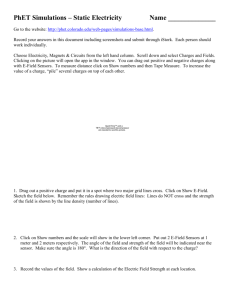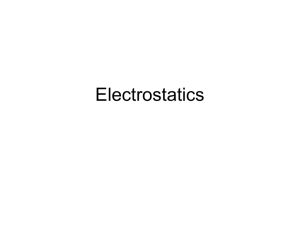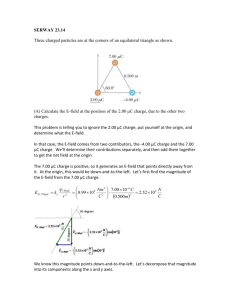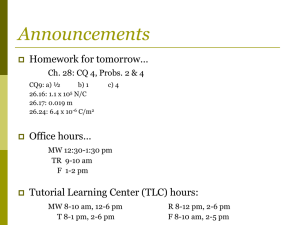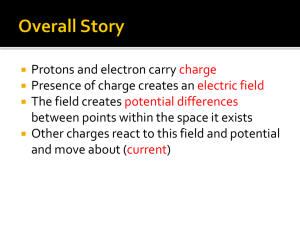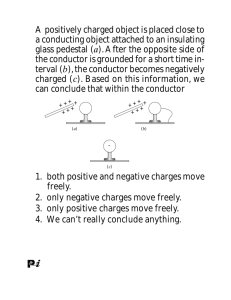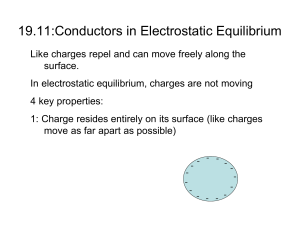Chapter 24 Electric Potential
advertisement
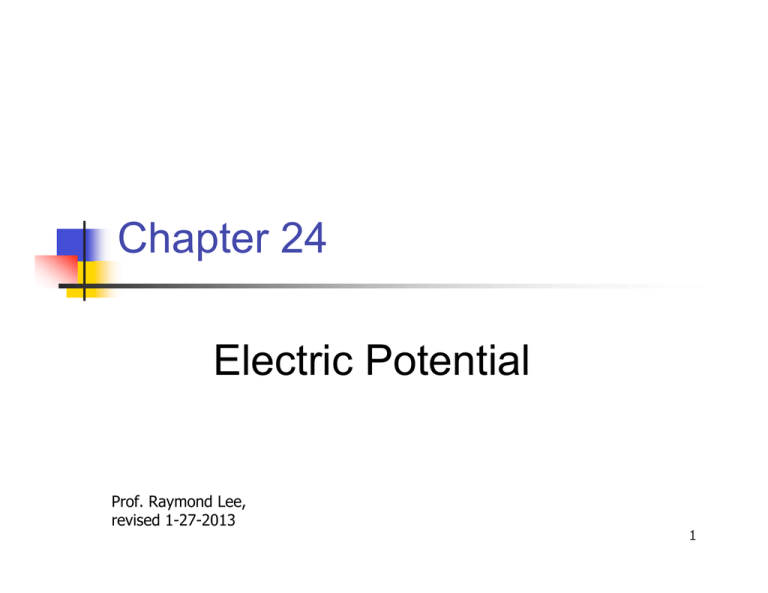
Chapter 24
Electric Potential
Prof. Raymond Lee,
revised 1-27-2013
1
• Electrical potential energy U
•
•
•
If a test charge q0 is put in electric field E,
then q0 experiences a force F = q0E
This force is conservative (i.e., pathindependent)
ds is an infinitesimal displacement vector
oriented tangent to any spatial path
2
• Electric U, 2
•
•
•
Work done by E-field is F•ds = q0E•ds
As field does this work, charge-field
system’s potential energy U changes by
!U = -q0E•ds
For finite displacement of charge from
A"B,
(Eqs. 24-17 & 24-18, p. 633)
3
• Electric U, 3
•
•
Since q0E is conservative, line integral
doesn’t depend on charge’s path
Thus !U = change in system’s PE
4
• Electric potential V
•
PE per unit charge U/q0 is the electric
potential, which is:
•
•
•
independent of q0’s value
defined at every point in an E-field
Define electric potential V = U/q0
5
• Electric V, 2
•
•
V is a scalar quantity since energy is a
scalar
As a charged particle moves in an Efield, it experiences change in potential
(Eq. 24-18, p. 633)
6
• Electric V, 3
•
•
•
Only V differences (i.e., !V) are meaningful
We often set V = 0 at some convenient
reference point in E-field
V is a scalar characteristic of an E-field,
independent of any test charges in that field
7
• Work & electric V
•
•
Assume a charge q is moved in an Efield without changing charge’s KE
Then work Wapp done by an external
agent on charge q is: Wapp = !U = q !V
(Eqs. 24-13 & 24-14, p. 631)
•
Contrast this with work W done by field
itself on charge q: W = –!U = –q !V
(Eq. 24-1, p. 628)
8
• Units of !V
•
•
1 V = 1 J/C
(Eq. 24-9, p. 630)
• V is a volt
• 1 joule of work is needed to move a 1-C charge
through a !V = 1 volt
Also, 1 N/C = 1 V/m {= 1 J/(C*m) = 1 N*m/(C*m)}
(see Eq. 24-10, p. 630)
•
Can interpret E-field as measure of spatial
gradient of V
9
• Electron volt
•
•
•
An energy unit commonly used in atomic &
nuclear physics is electron-volt (eV)
1 eV is energy that a charge-field system
gains or loses when a charge of |e| (electron
or proton) moves through !V = 1 volt
So 1 eV = 1.60 x 10-19 C•(1V) = 1.60 x 10-19 J
since 1 J = 1 C•V (see p. 630)
10
• !V in a uniform E-field
•
•
Can simplify equations for !V if E-field
B
is uniform: VB–VA = !V = – # E•ds
A
B
= –E # ds = –Ed, where d = path
A
distance from A"B (see Sample Problem, p. 634)
– sign shows V at point B < V at point A
11
• Energy & E-field direction
•
•
When E-field points $, point
B is at lower V than point A
If a +test charge moves from
A"B, then charge-field
system loses PE (i.e., !V < 0)
(SJ 2008
Fig. 25.2,
p. 695)
12
• Energy & E-field direction, 2
•
•
•
System of +q0 & E-field loses electric U (i.e.,
!U < 0) when +q0 moves with field
True since E-field does work on +q0 when it
moves with field
A moving +q0 gains KE = PE lost by chargefield system (i.e., energy conservation)
13
• Energy & E-field direction, 3
•
•
•
If q0 is –, then !U > 0
System consisting of –q0 & E-field gains
U when –q0 moves in field’s direction
For –q0 to move with E-field, external
agent must do +work on the charge
14
• Equipotentials
•
•
•
(compare Fig. 24-5, p. 634)
Point B is at lower V than
point A
Points B & C are at same V
An equipotential surface is
any surface with continuous
distribution of points at
constant V
15
• Charged particle in uniform E-field
•
•
•
+q0 is released from rest
& moves with E-field
Then !V < 0 & !U < 0
Fe & a on +q0 are in Efield’s direction
(SJ 2008 Fig. 25.6, p. 696)
16
• !V & point charges
•
•
+point charge " E-field
pointing radially outward
Then !V from A"B is:
(SJ 2008 Eq. 25.10, p. 697)
17
• !V & point charges, 2
•
!V is independent of A"B path
Pick reference V = 0 at rA = %
•
Then V at point r is V = keq/r
•
(Eq. 24-26, p. 635)
18
• V for a point charge
•
•
Consider V in plane around
a point charge
Red line shows V ’s 1/r
dependence
(compare Fig. 24-7, p. 635)
19
• V for multiple charges
•
•
Net V from several point charges is & of
Vs from individual charges (superposition
principle)
Then
(Eq. 24-27, p. 636)
where V = 0 at reference distance r = %
20
• V for a dipole
•
•
•
Consider V for an electric
dipole (along y-axis)
Steep slope between +/charges shows strong
E-field here
V = ke*p*cos(')/r2 where
' = angle from dipole axis
(Eq. 24-30, p. 638)
(SJ 2008 Fig. 25.8, p. 698)
21
• E & V for infinite sheet of charge
•
•
•
Equipotential lines are
dashed blue lines
E-field lines are brown lines
Note equipotential lines are
everywhere ( E-field lines
(SJ 2008 Fig. 25.12, p. 701)
22
• E & V for a point charge
•
•
•
•
Equipotential lines are dashed
blue lines
E-field lines are brown lines
As before, equipotential lines
are everywhere ( E-field lines
Note that equipotentials are
closer together as V-gradient
steepens near charge
(SJ 2008 Fig. 25.12, p. 701)
23
• E & V for a dipole
•
•
•
Equipotential lines are dashed
blue lines
E-field lines are brown lines
As before, equipotential lines
are everywhere ( E-field lines
(SJ 2008 Fig. 25.12, p. 699)
24
• V for continuous charge distribution
•
•
Treat small charge element dq
as a point charge on an object
of finite size & arbitrary shape
Then potential dV at any point
due to dq is dV = kedq/r
(Eq. 24-31, p. 639)
(SJ 2008 Fig. 25.14, p. 703)
25
• V for continuous charge distribution, 2
•
To find total V, must integrate to include
contributions from all elements dq:
V = ke #dq/r
•
(Eq. 24-32, p. 639)
assumes reference value V(r =%) = 0 for
P infinitely far away from charged object
26
• V for a uniformly charged ring
•
P is on ( central axis of
uniformly charged ring of
radius a & total charge Q
(SJ 2008 Eq. 25.21, p. 705)
(SJ 2008 Fig.
25.15, p. 704)
27
• V for a uniformly charged disk
•
Ring of radius a &
surface charge density !
(compare Eq. 24-37, p. 640)
(compare Fig. 24-13, p. 640)
28
• V for finite line of charge
•
Rod of length l has
total charge Q & linear
charge density "
(compare Fig.
24-12, p. 639)
(compare Eq. 24-35, p. 640)
29
• V for uniformly charged sphere
•
•
•
Solid insulating sphere of radius
R & total charge Q
For r > R, V = keQ/r
For r < R {e.g., inner radius D},
VD = keQ(3–r2/R2)
2R
(SJ 2004 Fig. 25.19, p. 777)
30
• V for uniformly charged sphere, 2
•
•
•
Parabolic VD curve is for
potential inside sphere, & it
smoothly joins VB curve
Note that ED = keQr/R3, just
as found earlier
Hyperbolic VB curve is for
potential outside sphere
(SJ 2004 Fig.
25.20, p. 777)
31
• Finding E from V
•
•
•
Assume E has only an x-component, so that
Ex = – dV/dx (Eq. 24-41, p. 641)
Similar statements apply to Ey & Ez components
Equipotential surfaces are always ( E-field lines
passing through them
32
• E-field from V, general
•
•
In general, V varies in all 3 dimensions
Given V(x,y,z), you can find Ex, Ey, & Ez
as partial derivatives of V:
(Eq. 24-41, p. 641)
33
• U for multiple charges
•
For 2 charged particles, system’s
PE (or U) is U = keq1q2/r12
(see Eq. 24-43, p. 643)
•
•
If 2 charges have same sign,
U > 0 & must do work to bring
them together (i.e., to ) U)
If 2 charges have opposite signs,
U < 0 & must do work to move
them apart () U again)
34
• U for multiple charges, 2
•
•
If > 2 charges, find U for each
charge pair & add these Us
So for 3 charges:
(see Sample Problem, p. 643)
•
Result is independent of order of
moving charges to given
positions
35
• V from charged conductor
•
•
•
•
Consider 2 points A & B on surface of
arbitrary charged conductor
E = 0 inside conductor & on
conductor’s surface, have E ( surface
Thus always have E ( displacement
ds along surface, so E•ds = 0
As a result, !V between A & B = 0
(SJ 2008 Fig. 25.18, p. 707)
36
• V from charged conductor, 2
•
•
•
V = constant everywhere on surface of charged
conductor in equilibrium (i.e., !V = 0 between
any 2 points on surface)
Surface of any charged conductor in
electrostatic equilibrium is equipotential surface
Since E = 0 inside conductor, we know that
V = Vsurface (a constant) throughout interior
37
• E compared to V
•
•
V(r) * 1/r, but E(r) * 1/r 2
In space surrounding a charge, it
sets up:
•
•
vector E-field related to force
scalar potential V related to energy
V(r) & E(r) for conducting
sphere (SJ 2008 Fig. 25.19, p. 707)
38
• Irregularly shaped objects
•
•
•
•
Charge density + is high where
radius of curvature is small & low
where radius of curvature is large
Model conductor as collection of
point charges with E(r) = keq/r 2
So for nearby uncharged surfaces,
distance r to conductor varies
more for its small-curvature parts
E-field is large near convex points
with small radii of curvature & is
largest at sharp points
(SJ 2004 Fig. 25.23, p. 779)
39
• Irregularly shaped objects, 2
•
•
E-field lines are everywhere ( conducting surface
Equipotential surfaces are everywhere ( E-field
lines
(SJ 2004 Fig.
25.24, p. 779)
40
• Cavity in a conductor
•
•
Assume:
(1) an irregularly shaped cavity
is inside a conductor
(2) no charges within cavity
Know that E = 0 inside
conductor. Why is this so?
(SJ 2008 Fig. 25.26, p. 780)
41
• Cavity in a conductor, 2
•
•
•
•
E-field inside doesn’t depend on charge
distribution on conductor’s exterior
For all paths between points A & B, potential
B
difference VB–VA = – #AE•ds = 0 (i.e., all points
on conductor’s cavity wall are at same V)
Since this holds for all paths on inner wall,
must have E = 0 N/C everywhere inside cavity
Thus a cavity with (a) conducting walls &
(b) no enclosed charges is a field-free region
42
• Corona discharge
•
•
If E-field near a conductor is large, free
electrons from random ionizations of air
molecules accelerate away from these
“parent” molecules
These free electrons
can ionize additional
molecules near
conductor
60 kV Tesla coil discharge
43
• Corona discharge, 2
•
•
•
This " more free electrons
Corona discharge is glow that results
from recombination of these free
electrons with ionized air molecules
Ionization & corona discharge are most
likely to occur near very sharp points
where + is largest
44
45
Millikan Oil-Drop Experiment –
Experimental Set-Up
46
Millikan Oil-Drop Experiment
,
,
,
Robert Millikan measured e, the
magnitude of the elementary charge on
the electron
He also demonstrated the quantized
nature of this charge
Oil droplets pass through a small hole &
are illuminated by a light
47
Oil-Drop Experiment, 2
,
,
With no electric field
between the plates,
the gravitational
force & the drag
force (viscous) act
on the electron
The drop reaches
terminal velocity with
FD = mg
48
Oil-Drop Experiment, 3
,
When an electric field
is set up between the
plates
,
,
The upper plate has a
higher potential
The drop reaches a
new terminal velocity
when the electrical
force equals the sum
of the drag force &
gravity
49
Oil-Drop Experiment, final
,
,
The drop can be raised & allowed to fall
numerous times by turning the electric
field on & off
After many experiments, Millikan
determined:
,
,
q = ne where n = 1, 2, 3, …
e = 1.60 x 10-19 C
50
Van de Graaff
Generator
,
,
,
,
Charge is delivered continuously to
a high-potential electrode by means
of a moving belt of insulating
material
The high-voltage electrode is a
hollow metal dome mounted on an
insulated column
Large potentials can be developed
by repeated trips of the belt
Protons accelerated through such
large potentials receive enough
energy to initiate nuclear reactions
51
Electrostatic Precipitator
,
,
,
,
,
An application of electrical discharge in
gases is the electrostatic precipitator
It removes particulate matter from
combustible gases
The air to be cleaned enters the duct &
moves near the wire
As the electrons & negative ions created by
the discharge are accelerated toward the
outer wall by the electric field, the dirt
particles become charged
Most of the dirt particles are negatively
charged & are drawn to the walls by the
electric field
52
Application – Xerographic
Copiers
,
,
The process of xerography is used for
making photocopies
Uses photoconductive materials
,
A photoconductive material is a poor
conductor of electricity in the dark but
becomes a good electric conductor when
exposed to light
53
The Xerographic Process
54
Application – Laser Printer
,
The steps for producing a document on a laser
printer is similar to the steps in the xerographic
process
,
,
Steps a, c, & d are the same
The major difference is the way the image forms on
the selenium-coated drum
,
,
,
A rotating mirror inside the printer causes the beam of the
laser to sweep across the selenium-coated drum
The electrical signals form the desired letter in positive
charges on the selenium-coated drum
Toner is applied & the process continues as in the
xerographic process
55
Potentials Due to Various
Charge Distributions
56

